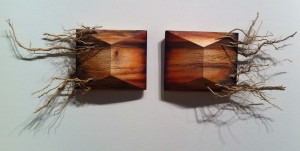
Photo by Adelle Brodbeck
By Adelle Brodbeck
Transcript Reporter
Sunday, Oct. 13, the Ross Art Museum welcomed two new exhibits from local artists Melinda Rosenberg and Rod Bouc.
Rosenberg’s work transforms reclaimed wood into creative sculptures while Bouc takes to another side of nature through his intricate landscapes and portraits of rainclouds.
The opening reception matched the art’s sophistication. Students and community members roamed the gallery admiring the different pieces and sipping lemonade while a live harp played in the background.
Both Rosenberg and Bouc agreed the opening was a success.
“The harp was beautiful, snacks yummy and a bunch of friends and family came,” Rosenberg said.
Rosenberg decided to showcase her work for OWU due to her many connections with the surrounding community, including her membership at the North Unitarian Universalist Church.
She also said she had previously shown at the Ross at the beginning of her career in 1987.
“I wanted to complete a cycle of making and showing by showing again at Ohio Wesleyan,” she said.
Bouc said it was a privilege to show at OWU and enjoyed the opening reception. He said he thinks the Ross is “one of the best exhibition spots in Ohio.”
“There was a nice crowd and the show looked great,” he said. “I love showing my work to others.”
Rosenberg’s creates geometric and visually exciting sculptures from old barn sidings, ladders, rocking chairs and various trees such as pine and maple.
“My work is very much about Ohio and its changing landscape,” she said.
Her series titled “Hokey Pokey” playfully recreates the beloved but somewhat corny dance through repurposed bits of rocking chairs.
“The arms and legs of rocking chairs needed to do something,” she said about her inspiration for the series. “It started with the fact that a rocking chair has body parts. I also wanted to do something playful and free.”
“Anaphase” shows a more serious edge to Rosenberg’s work. It’s made from a pair of wood blocks sanded down and painted to create an emphasis on the space between the two and their connection. She also added a bundle of roots “to add to the sense of pulling apart and earthiness of the piece.”
“When I was looking for a title I looked up division in the thesaurus to find ‘anaphase,’” she said. “Anaphase is the moment in cell division just prior to the separation of cells, which seemed to capture the tension of the piece.”
Bouc’s exhibit, titled “Nature’s Edge,” takes the same concept of tension within our natural world and presents it in vivacious paintings and drawings.
“I’ve been fascinated with how places in the country or the sky can inspire you, calm you, frighten you,” Bouc said about his inspiration. “We go places to evoke feelings. We look to the sky and are awestruck. It’s very interesting to me. I try to evoke those feelings in my (art).”
Bouc’s exhibit features art from three different areas, charcoal portraits of clouds, landscapes of serene farm life and depictions of threatening tornadoes.
One particular pair of paintings in the exhibit, “Fields and Dusk” and “Fields at Dusk (Ghost),” show Bouc’s talent and resourcefulness. The works are monotypes, involve creating a painting on glass, transferring that paint onto paper and then using the residue to create a ghostlike reprint of the first image.
“Monotypes go back centuries,” he said about the technique used to create the paintings. “Yet, they are not well known. I did my first monotypes in graduate school at OSU in the late 1970’s. Monotype is a great process of printmaking for painters like myself.”
Monotypes Bouc said that what he finds particularly interesting about the process is that it always produces a distinctive image.
“Often, I work on and run the plate through multiple times and get a kind of series of prints that result in images that are similar, yet unique,” he said. “Each print is original. It’s a very creative process and there are very few rules as in most art-making.”
Bouc said his exhibit shows a culmination of his work throughout his many years as an artist.
“It’s all experimentation,” he said. “As you can imagine, the work reflects where I am in my life, how I feel, is echoed in the work. It’s not necessarily intentional. I don’t say, ‘I feel sad today, I’m going to make a sad painting.’ It just comes out during the process of making the work.”